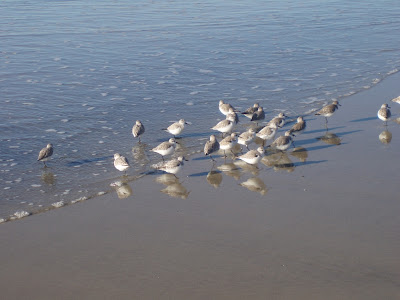
Mountain bikes, hikers, dog-walkers, horse-back riders, and ordinary walkers share the trails through the remarkably preserved Los Penasquitos Canyon. Though housing developments surround the canyon, and large homes are visible on the ridges of the canyon above the trail, this area has been beautifully preserved with small streams and pools, attractive trees, vegetation, and lichen-covered rocks.
The trail parallels the creek, which at this season has some water -- but not enough to block the route. Today was sunny, and a pleasant temperature for going the length of the canyon. We sat on the bank of a rocky little dry stream and ate our sandwiches at mile 2. Our turn-around point was a hilltop overlooking a little canyon with cascading water.


The little canyon is closer to a different park entrance than the one where we started -- as a result, I suppose, many people were wading in the water there.
Coming back, we sometimes chose the narrower trails that hug the sides of the stream, or occasionally occupy the dry creekbed. Little boardwalks span the deeper waters of the stream where needed. During storms and their aftermath, the trails are closed.
 An American Pioneer Story
An American Pioneer StoryThe earliest European inhabitants settled here on a Spanish Land Grant to Captain Francisco Maria Ruis, commandant of the San Diego Presidio. Archaeologists have excavated a ranch house built for him in 1824. Another house, from 1862, is now the park headquarters. We didn't visit these buildings, but only hiked.
John Joseph Eichar was a cook at the ranch that once occupied the canyon, and is buried beside the trail where we were walking -- his marble tombstone, as shown, is smooth and perfectly preserved. Eichar's great grandfather was a younger son of the prince of Eichstadt, Bavaria. In 1750, the prince and his wife left Germany; along the way, they died, leaving two young sons. These sons were then raised by quakers in Pennsylvania.
Their descendant John Joseph Eichar was born in 1825 in Greensberg, PA, as it says on his tombstone. The details of his life appear to be obscure, except that he seems to have been a ranch cook, and died of TB in January, 1882. The information appeared on a plaque beside the well-tended grave. We were somewhat surprised to see this little remnant of history.
 Today was sunny and beautiful for a safari in the Wild Animal Park. We spent most of our time in Africa. Finally, I saw a gnu -- Lenny's photo.
Today was sunny and beautiful for a safari in the Wild Animal Park. We spent most of our time in Africa. Finally, I saw a gnu -- Lenny's photo.

 We walked through the Hidden Rain Forest also. The many colors of the birds are striking.
We walked through the Hidden Rain Forest also. The many colors of the birds are striking.














































